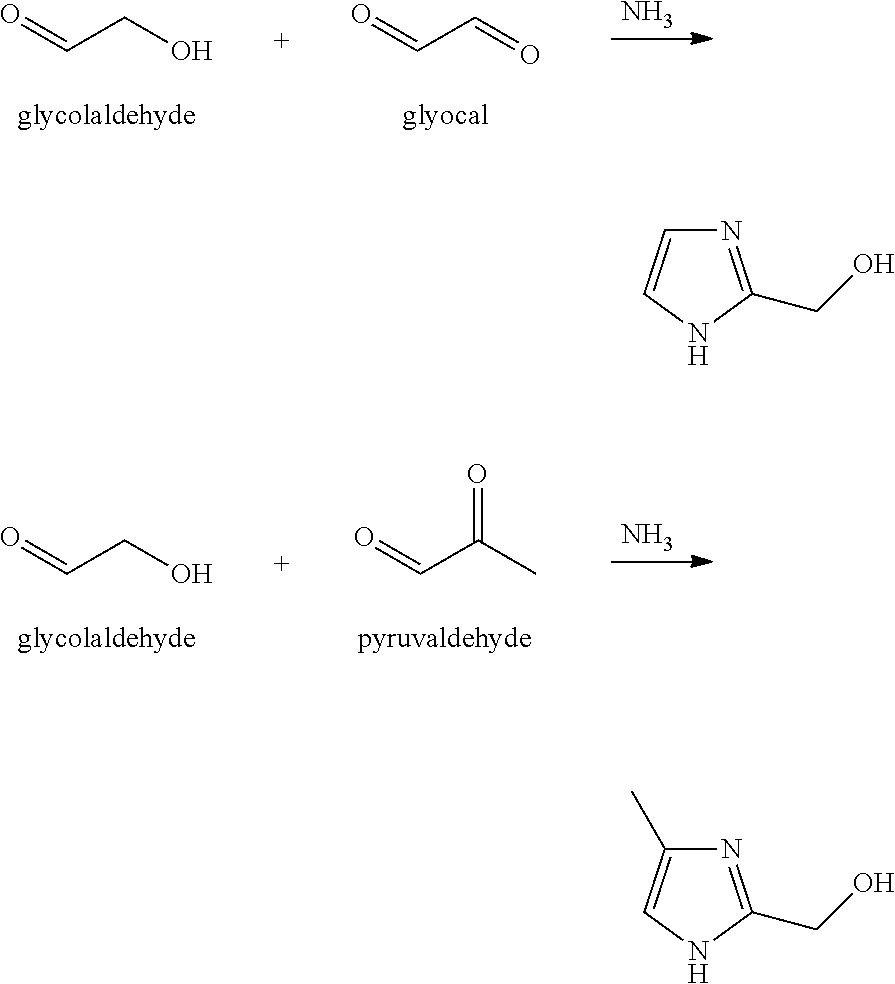Processes and cataylsts for the selective hydrogenation of compounds having carbonyl carbon atoms
a technology catalysts, which is applied in the preparation of carbonyl compounds, separation processes, organic chemistry, etc., can solve the problems of significantly reducing the utilization of glycolaldehyde and other desired intermediates, affecting the desired subsequent reaction, and affecting the utilization rate of carbonyl carbon atoms, etc., to achieve different relative volatility, high susceptibility to hydrogenation, and low susceptibility to hydrogenation
- Summary
- Abstract
- Description
- Claims
- Application Information
AI Technical Summary
Benefits of technology
Problems solved by technology
Method used
Image
Examples
example 1
Hydrogenation of Furfural
[0056]A liquid mixture of 24 grams of furfural and 62 grams of methanol solvent was charged to a 300 cc high pressure reactor (Parr Instrument Company). To this mixture was added 2.05 grams of particulate, solid catalyst with the metal contents of 2 wt-% Ru / 2 wt-% Sn / 0.5% wt-% Pt, disposed on a carbon support. The reactor was purged with hydrogen (3×500 psi) while continuously stirring the reaction mixture at 800 rpm. Thereafter, the reactor was pressurized with hydrogen to 1200 psi, and the reaction mixture was heated to 65° C. and maintained at this temperature for 1 hour. The reaction mixture was then cooled to room temperature and the reactor was opened. The solid and liquid contents were removed from the reactor and filtered by vacuum filtration to separate the catalyst. The filtrate was subjected to rotary evaporation to remove the methanol solvent. The remaining liquid was analyzed for its composition using nuclear magnetic resonance (NMR) spectroscop...
example 2
Selective Hydrogenation of Pyruvaldehyde
[0058]A liquid composition of 15.1 grams of pyruvaldehyde, concentrated to 40 wt-% in water, was added to 86 ml of water, and the resulting mixture was charged to a 300 cc high pressure reactor (Parr Instrument Company). To this mixture was added 1.96 grams of particulate, solid catalyst with the metal contents of 2 wt-% Ru / 2 wt-% Sn / 0.5% wt-% Pt, disposed on a carbon support. The reactor was purged with hydrogen (3×500 psi) while continuously stirring the reaction mixture at 800 rpm. Thereafter, the reactor was pressurized with hydrogen to 1200 psi, and the reaction mixture was heated to 65° C. and maintained at this temperature for 1 hour. The reaction mixture was then cooled to room temperature and the reactor was opened. The solid and liquid contents were removed from the reactor and filtered by vacuum filtration to separate the catalyst. The filtrate was analyzed for its composition using NMR spectroscopy and was found to contain mostly (...
example 3
Selective Hydrogenation of Glyoxal
[0060]A liquid composition of 15.1 grams of glyoxal, concentrated to 40 wt-% in water, was added to 85 ml of water, and the resulting mixture was charged to a 300 cc high pressure reactor (Parr Instrument Company). To this mixture was added 2.17 grams of particulate, solid catalyst with the metal contents of 2 wt-% Ru / 2 wt-% Sn / 0.5% wt-% Pt, disposed on a carbon support. The reactor was purged with hydrogen (3×500 psi) while continuously stirring the reaction mixture at 800 rpm. Thereafter, the reactor was pressurized with hydrogen to 1200 psi, and the reaction mixture was heated to 60° C. and maintained at this temperature for 1 hour. The reaction mixture was then cooled to room temperature and the reactor was opened. The solid and liquid contents were removed from the reactor and filtered by vacuum filtration to separate the catalyst. The filtrate was analyzed for its composition using NMR spectroscopy and was found to contain glycolaldehyde (14%,...
PUM
| Property | Measurement | Unit |
|---|---|---|
| temperature | aaaaa | aaaaa |
| partial pressure | aaaaa | aaaaa |
| particle size | aaaaa | aaaaa |
Abstract
Description
Claims
Application Information
 Login to View More
Login to View More - R&D
- Intellectual Property
- Life Sciences
- Materials
- Tech Scout
- Unparalleled Data Quality
- Higher Quality Content
- 60% Fewer Hallucinations
Browse by: Latest US Patents, China's latest patents, Technical Efficacy Thesaurus, Application Domain, Technology Topic, Popular Technical Reports.
© 2025 PatSnap. All rights reserved.Legal|Privacy policy|Modern Slavery Act Transparency Statement|Sitemap|About US| Contact US: help@patsnap.com



